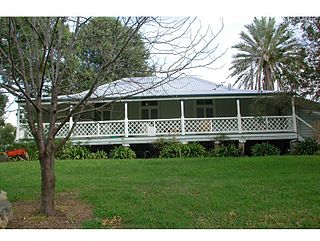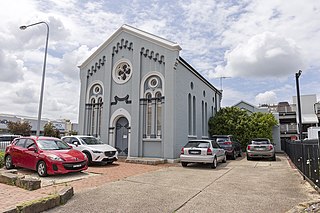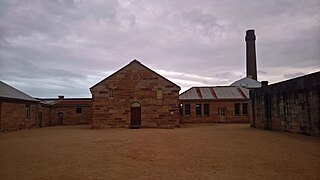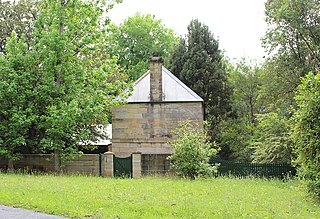
The Great North Road is a historic road that was built to link early Sydney, in the Colony of New South Wales, now Australia, with the fertile Hunter Valley to the north. Built by convicts between 1825 and 1836, it traverses over 260 kilometres (162 mi) of the rugged terrain that hindered early agricultural expansion.

Tahmoor railway station is a heritage-listed railway station located on the Main Southern line in the town of Tahmoor, part of the Wollondilly Shire local government area of New South Wales, Australia. The property was added to the New South Wales State Heritage Register on 2 April 1999 where it is also known as the Tahmoor Railway Station Group and Lupton's Inn. The station opened on 13 July 1919 at the same time as a new alignment between Picton and Mittagong railway stations.

Mortimer William Lewis was an English-born architect, surveyor and public servant who migrated to Australia and became Colonial Architect in the colony of New South Wales from 1835 to 1849. Lewis was responsible for designing and overseeing many government buildings in Sydney and rural New South Wales, many of which are heritage listed.

Wollombi is a small village in the Hunter Region of New South Wales, Australia. It is within the Cessnock City Council LGA, situated 29 kilometres (18 mi) southwest of Cessnock and 128 km (80 mi) north of Sydney. To the south is the village of Laguna, to the east, the village of Millfield and to the north, the village of Broke.

Jondaryan Homestead is a heritage-listed homestead at Evanslea Road, Jondaryan, Toowoomba Region, Queensland, Australia. It was the base of the former Jondaryan pastoral station, which was originally taken up in 1840, and at one time was the largest freehold station in Queensland. The site contains the current house, which was built after the original was destroyed by fire in 1937, the original kitchen dating from 1844, and a kitchen, butcher's shop, shearer's quarters, stables, dairy, toilet block and store, many dating from the 1860s. It also contains the remains of horse stalls, a slaughterhouse, hide store, and Chinese gardener's glasshouse. It was added to the Queensland Heritage Register on 21 October 1992.

Parson's Inn is a heritage-listed former hotel at Raglan Station Road, Raglan, Gladstone Region, Queensland, Australia. It was built from c. 1885 to 1950s. It was added to the Queensland Heritage Register on 31 July 2006.
Millfield is a town in the City of Cessnock municipality of New South Wales. It had a population of 1,006 as of the 2016 census.

The Collins Street wooden terraces are two sets of heritage-listed residences at 24–40 and 42–44 Collins Street, Kiama, New South Wales, Australia. They were built in the 1870s and 1880s. They were added to the New South Wales State Heritage Register on 2 April 1999.
Overseers' Cottages Remains is a heritage-listed archaeological site, now incorporated into the Glasshouse entertainment centre, at 30-44 Clarence Street, Port Macquarie, Port Macquarie-Hastings Council, New South Wales, Australia. It is the remains of cottages for convict overseers', built from 1823 to 1830 by convict labour. The property is owned by Port Macquarie-Hastings Council. It was added to the New South Wales State Heritage Register on 13 August 2010.

The Maitland Synagogue is a heritage-listed former synagogue located at 47 Church Street, Maitland, in the City of Maitland local government area of New South Wales, Australia. It was designed by John W. Pender and built in 1879 by James Pritchard. It is also known as The Old Synagogue. It was added to the New South Wales State Heritage Register on 2 April 1999.

Berrima Post Office is a heritage-listed post office at Argyle Street, Berrima, in the Southern Highlands of New South Wales, Australia. It was built in 1886 by R. N. Matthews. It was added to the New South Wales State Heritage Register on 2 April 1999.
Jellore Cottage is a heritage-listed house at 16 Jellore Street, Berrima, Wingecarribee Shire, New South Wales, Australia. It is also known as Munday Cottage. It was added to the New South Wales State Heritage Register on 2 April 1999.

Prison Barracks Precinct is a heritage-listed prison precinct at Cockatoo Island, Sydney Harbour, New South Wales, Australia. It was added to the Australian Commonwealth Heritage List on 22 June 2004.

Timber Slab Cottage is a heritage-listed residence at 44 Barden Street, Tempe, Inner West Council, Sydney, New South Wales, Australia. It was built from 1840 to 1850. It is also known as Dover. It was added to the New South Wales State Heritage Register on 29 September 2000.

The Weatherboard Inn archaeological site is a heritage-listed former grazing ground, military post, staging inn and road building depot and now public park located at 1-15 Matcham Avenue, Wentworth Falls, City of Blue Mountains, New South Wales, Australia. It was built from 1814 to 1827. It is also known as Weatherboard Inn Archaeological Site. The property is owned by the Blue Mountains City Council. It was added to the New South Wales State Heritage Register on 2 April 1999.

Old Great North Road (Devine's Hill to Mount Manning Section) is a heritage-listed section of former main road, now walking track and service road, between Wisemans Ferry and Mount Manning, New South Wales, Australia. It was designed by Surveyor-General Thomas Mitchell and built from 1826 to 1834 by convict road gangs. It was added to the New South Wales State Heritage Register on 2 April 1999.

Goldfinders Inn is a heritage-listed former inn, guesthouse, general store and post office and now residence at 164 Old Bells Line of Road, Kurrajong, City of Hawkesbury, New South Wales, Australia. It was built from 1809 to 1830 by John Lamrock. It is also known as Gold Finders Rest, Kurrajong General Store and Kurrajong Post Office. It was added to the New South Wales State Heritage Register on 21 October 2016.

Great North Road (Mount Manning to Wollombi Section) is a heritage-listed road alignment, partly in use and partly abandoned, between Mount Manning and Wollombi, New South Wales, Australia. It was built between 1830 and 1832 by convict road gangs, having been surveyed by Heneage Finch (1830–1831) and thereafter by L. V. Dulhunty. It was added to the New South Wales State Heritage Register on 2 June 2009.

Hartley historic site is a heritage-listed historic village located adjacent to the Great Western Highway, Hartley, City of Lithgow, New South Wales, Australia. It was built from 1837 to 1850. It is also known as Hartley Historic Site and Hartley Township. The property is owned and protected by Office of Environment and Heritage, an agency of the Government of New South Wales. It was added to the New South Wales State Heritage Register on 2 April 1999.

Australiana Pioneer Village is a heritage-listed open-air museum at Rose Street, Wilberforce, New South Wales, an outer suburb of Sydney, Australia. It was built from 1969 to 1970. The property is owned by the Hawkesbury City Council.






















